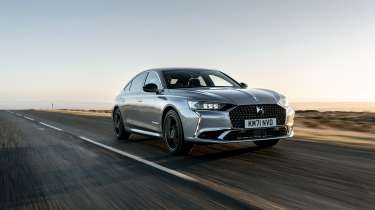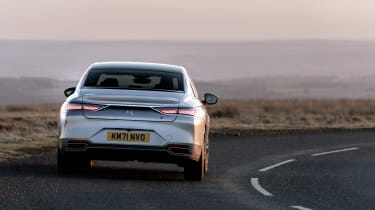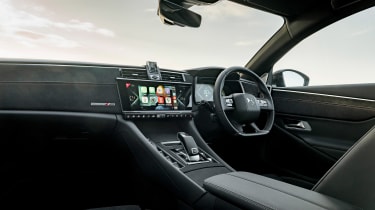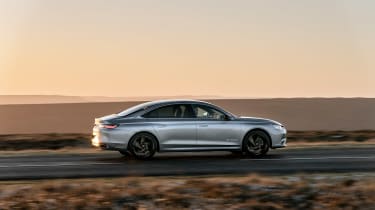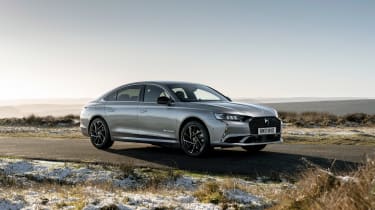DS9 E-Tense 2022 review – a French twist on the executive recipe
A comfortable, finely detailed take on an executive saloon, but there are gaps in its repertoire
Right from the off, it’s safe to say the DS9 is not the usual ‘evo’ car, but then you probably already knew that before clicking onto this review. But you might be interested to know what a modern French luxury saloon is like to drive, given they don’t really exist in a modern context, and whether it captures any of the magic of its illustrious namesakes from the ’60s and ’70s.
The DS9, developed under the PSA group before its Stellantis merger with FCA was in full swing, is a large luxury saloon that shares its basic underpinnings with the Peugeot 508. In comparison to the Pug, the DS9 has a little more room between its axles, but fundamentally shares its MacPherson strut front and multi-link rear suspension, which does without any clever hydro-pneumatic or air systems.
High-specification DS9s do get a camera-assisted active damper system that reads the road ahead and prepares each corner for any incoming intrusions, but this software-based system has been in use by brands such as Mercedes-Benz and Audi for decades, and generally in conjunction with more sophisticated air-suspension hardware.
The powertrain options are a little more interesting, with two plug-in hybrid options that share a turbocharged 1.6-litre four-cylinder PSA engine, but differ with their hybrid modules. Base models feature a 247bhp-combined set-up that powers the front wheels, with a single 109bhp electric motor integrated into the eight-speed transmission. Economy ratings vary depending on the driving conditions, but on-paper DS suggest it’ll reach up to 232mpg, but 50mpg-ish is more on the money from our experience of running on longer trips. It will cruise for up to 30 miles on electric drive if the 11.8kWh battery pack is topped up, but comes with the odd feeling of being spun through a traditional gearbox.
More reviews
Group tests
- Alpine A290 v Alpine A110 – how much DNA do they really share?
- Ariel Atom 4R v Caterham Seven ‘evo25’: power-to-weight heroes go head-to-head
- Caterham Super Seven 600 v Super Seven 2000
- Levante v T1
- Corvette Stingray v Porsche Cayman GTS v Audi R8 RWD
- Great Ferrari hypercars driven: 288 GTO, F40, F50 and Enzo head-to-head
- Hardcore Ferrari V8 specials go head-to-head
- Lamborghini Aventador Ultimae v Lamborghini Countach
- Lotus Emira v Morgan Plus Four – four-cylinder Brits go head-to-head
- Toyota GR86 v BBR Mazda MX-5: supercharged drop-top battles sports coupe
In-depth reviews
- Abarth 600e 2025 review – Italy gives the Alpine A290 something to worry about
- Alpine A110 review – distinctive, lightweight and unforgettable to drive
- Audi R8 (2015 - 2024) review – the ultimate soft-focus supercar
- Bentley Continental R Mulliner: review, history and specs
- BMW 5-series review – is this still Munich’s anchor model?
- BMW 1-series review – Munich’s Audi A3 rival gains focus
Long term tests
- Abarth 695C Turismo Fast Fleet test – 10,000 miles in the Italian hot hatch
- Alfa Romeo Giulia Veloce Fast Fleet test – 7000 miles in the sharp Italian saloon
- Alpina B10: end of term report
- Alpina B10
- Ford Mustang GT
- Ford Mustang GT
- Ford Mustang GT
- Land Rover Defender 110 Fast Fleet test – 9000 miles in the go-anywhere SUV
- Maserati Ghibli Trofeo Fast Fleet test – 4000 miles in the Ferrari-powered saloon
- Mitsubishi Evo MR 340
Review
- New Aston Martin DBS 770 Ultimate review – 759bhp super-GT driven
- New Bentley Batur 2023 review – can it possibly be worth £1.65m?
- 2023 Chevrolet Corvette C8 Z06 review – the American 911 GT3?
- Kia EV6 GT-Line S prototype review – the EV that shows how it’s done
- BBR Supercharged Mazda MX-5 (ND) 2023 review – tuned 250bhp roadster driven
- MG4 Trophy 2023 review
Reviews
- Abarth 695 75 Anniversario edition 2024 review – a fitting send-off for Abarth’s hot supermini?
- Abarth 500e 2023 review
- AC Cobra 378 Superblower MkIV 2021 review – another V8 Cobra, but with a GM heart this time
- Acura Integra Type S 2024 review – a Honda Civic Type R with added restraint
- Alfa Romeo Giulia 2025 review – get one while you still can
- Alfa Romeo SZ: history, review and specs of an icon
- Alfa Romeo 1750 TBi
- Alpina B3 GT Touring 2025 review – a 190mph alternative to the BMW M3 Touring
The second powertrain is borrowed from the Peugeot 508 PSE. Total system power is a much more impressive 355bhp, made up from 197bhp and 221lb ft of torque being derived from the petrol engine, coupled to a pair of electric motors. The one on the front axle is the same as the base model, but there’s an additional 111bhp motor driving the rear axle. The front motor also produces 236lb ft from 500rpm through to 2500rpm, with the rear providing an additional 122lb ft from zero revs to 4760rpm.
In isolation, calibration of the hybrid systems is rather good, with smooth actuation and very impressive isolation of the petrol engine unless you ask for a full-throttle kick-down. Hybrid mode will generally start up and operate at low speeds on the electric motor, but you’ll need to switch over to ‘Electric’ mode to lock it in during high-speed driving.
Fundamentally, these cars are not about driving quickly, and every element of their driving demeanour suggests just that, with a throttle and brake pedal that major on smoothness, light steering that’s effort-free and quite slow of ratio lock-to-lock.
However, this interpretation of luxury driving, while well-intentioned, isn’t quite executed with the success you’d hope due to a variety of factors. First, while the powertrain is well suppressed, wind and road noise suppression isn’t particularly impressive. Things are fine on smooth surfaces, but the UK’s rougher roads do highlight a lack of overall refinement in the cabin.
When in all-electric mode, particularly, it’s the suspension that actually makes most of the noise, with constant knocking coming from both ends when going over rough sections of road that make it sound like a 200,000-mile old E-class minicab. Bump absorption isn’t particularly brilliant, either, despite our car running on the smaller 19-inch wheels, as it’s all too keen to judder over sharp road intrusions.
This compromised primary ride quality doesn’t feel derived from springs being too stiff or tyres being too low-profile, but lack of resilience in the suspension. Drive over one of those killer narrow speed bumps and the front and rear axles will shudder and jump about – not something that you’d find in a rival BMW or Audi.
The irony of all this is that the DS9 actually corners with some semblance of competence – it’s not a 5-series, or even close to be frank, but lean into the body roll and there’s some structure to the chassis that feels fundamentally well balanced, and thanks to an accurate steering rack, it doesn’t lament you driving with a bit of purpose.
Away from the driving experience, the DS9 is also a mixed bag. The interior is very plush, and feels both quite special and oddly cocoon-like with its walls of leather, or Alcantara in the case of our Performance Line-trim test car. Perceived quality is high – most touchpoints, the ones not shared with lesser Peugeot and Citroen models, feel great. The interior tech does take some acclimatisation, but once you’re informed it’s fine.
Yet the DS9 doesn’t really channel innovation or luxury like its predecessors. There are two schools of thought when it comes to challenging the established players. Build a car that’s like an Audi, Mercedes or BMW and it has to be better, something few, if any, new premium players have been able to achieve. The alternative is to give your customer something different, and in the DS9’s case, it's only USPs are some ornate stitching and a motorised clock-face, and that just don’t really cut the mustard when the standards of rivals from Germany are just so high.
Prices and rivals
The DS9 comes in two trim levels and each with the aforementioned engine options. The basic Performance Line PHEV kicks off at £48,300, a fair chunk less expensive than the less-well equipped German competition. They are largely more powerful, though, and come in at anywhere between the £54,530 A6 50 TFSIe and £55,075 for a basic BMW 530e.
The PHEV 360 model with its triple-motor set-up starts where the German competition kick off at £55,300. Upgrade to the top-spec Rivali and it will cost a further £3000, regardless of engine. Of course, even an incredibly buoyant used car market can’t stop these high-priced French models from falling off a depreciation cliff, but then who buys cars with cash nowadays, anyway?

